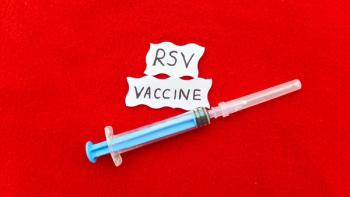
Biosimilar Stivant Shows Noninferior Efficacy and Comparable Safety to Reference Bevacizumab
Key Takeaways
- Stivant showed noninferior efficacy and comparable safety to Avastin in treating prethreshold type 1 ROP in preterm infants.
- The study involved bilateral intravitreal injections in 54 infants, with similar retinal vascularization and plus disease regression outcomes.
The mean time intervals between injection and complete retinal vascularization were similar between the biosimilar and its reference product.
When treating premature infants with prethreshold type 1 retinopathy of prematurity (ROP), Stivant (CinnaGen), a biosimilar to originator bevacizumab (Avastin; Genentech), exhibited noninferior efficacy to its reference product.
The study results, published in the Journal of Current Ophthalmology. also showed that the biosimilar has a comparable safety profile to its reference product.1
In the treatment of ophthalmic conditions, intravitreal injections play a significant role in routine practice. This administration method is available for many treatments, including antibiotics, antivirals, antifungals, corticosteroids, and anti-vascular endothelial growth factor (VEGF) agents. In certain conditions—such as diabetic retinopathy and age-related macular degeneration—the level of VEGF in the ocular tissue is higher. For these conditions, anti-VEGF agents, such as bevacizumab, are used.2
Bevacizumab is a recombinant, full-length, humanized antibody that binds all VEGF isoforms. Avastin had first been used for the treatment of colorectal cancers in 2004, and then it became popular among ophthalmologists for different diseases, such as choroidal neovascularization secondary to pathologic myopia, secondary to age-related macular degeneration, proliferative diabetic retinopathy, and ROP, among other conditions; however, these uses were initially off label.2
Biosimilars such as Stivant have emerged as a cost-effective alternative to certain biologics, offering broader access to treatment for patients who face barriers to accessing treatments. Early studies have demonstrated promising safety profiles and therapeutic effects, suggesting their potential as treatment options for retinal diseases like ROP; however, the development and regulation of biosimilars raise significant challenges, such as manufacturing variation and regulatory pathways varying across regions.1
For this nonrandomized, contralateral clinical trial, preterm infants with bilateral prethreshold type 1 ROP were enrolled. Participants received bilateral intravitreal bevacizumab administration, with the biosimilar Stivant (0.625 mg/0.025 mL) injected in the right eye and its reference product, Avastin, in the left eye. Patients were followed up weekly for 4 weeks, then biweekly until complete retinal vascularization. The primary outcome was the number of eyes with complete vascularization without rescue laser photocoagulation in each group. The secondary outcome was the time interval between intravitreal injection and complete retinal vascularization.1
Specifically, the primary outcome measure, retinal vascularization, is an indicator of efficacy, as it reflects the therapeutic response to treatment with Stivant and Avastin. Alternatively, safety was evaluated through the monitoring of adverse events (AEs), such as endophthalmitis, uveitis, and other ocular or systemic complications. Because of the limitations of the neonatal population, tests such as electroretinography, visual acuity, and optical coherence tomography could not be conducted.1
A total of 54 infants were enrolled in the study, with the mean age at intravitreal bevacizumab injection being 34.5 ± 2.5 weeks (range: 30–41 weeks). According to the findings, the mean ± SD of the time intervals between injection and complete retinal vascularization was about 25.55 ± 12.66 and 25.46 ± 12.45 weeks for the Stivant and Avastin groups, respectively (P = .59). Plus disease, which was characterized by venous dilation and arteriolar tortuosity in the posterior pole, was evaluated in all patients. Regression of plus disease was observed in all treated eyes that achieved complete retinal vascularization following administration of either Stivant or Avastin. The regression of plus disease occurred at a similar rate between the 2 groups (11.3%; P = 1), according to the authors, which further supports the noninferiority of Stivant in the achievement of clinical regression within ROP activity. Of note, there were no local or systemic drug-related AEs in the eyes receiving Stivant or Avastin.1
“The main limitation of this study was the relatively small sample size. However, as the first utilization of intravitreal injection of Stivant in [neonates with ROP], this investigation should be considered a pilot study. This study involved a moderate sample size of 44 preterm infants, providing preliminary comparative data on the efficacy and safety of Stivant and Avastin in prethreshold type 1 ROP. While these findings suggest that Stivant exhibited comparable efficacy to Avastin in terms of retinal vascularization and safety, the study should be considered exploratory, serving as a basis for future, larger randomized controlled trials,” wrote the study authors.1
REFERENCES
1. Mojtaba A, Zohreh G, Nasser S, et al. Comparative Efficacy and Safety of Biosimilar Bevacizumab (Stivant®) versus Reference Product (Avastin®) in Prethreshold Type I Retinopathy of Prematurity. J Curr Ophthalmol. 2025;36(4):407-412. doi:10.4103/joco.joco_178_24
2. Afarid M, Sadegi Sarvestani A, Rahat F, Azimi A. Intravitreal Injection of Bevacizumab: Review of our previous Experience. Iran J Pharm Res. 2018;17(3):1093-1098.
Newsletter
Stay informed on drug updates, treatment guidelines, and pharmacy practice trends—subscribe to Pharmacy Times for weekly clinical insights.




















































































































































































































